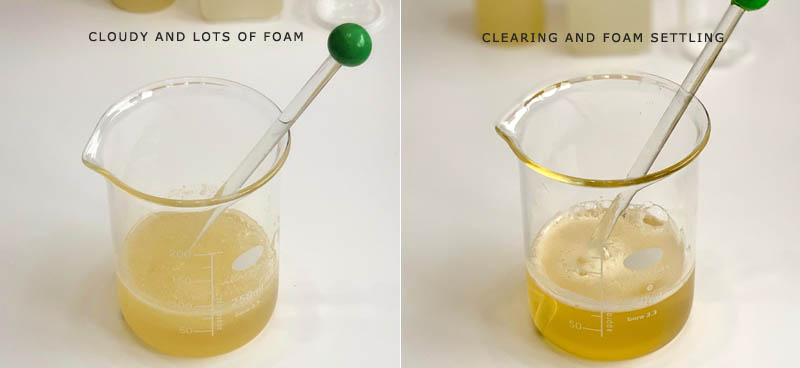
[ad_1]
Up to date: 19.03.24
On this publish, we’re going to present you tips on how to make a natural pure shampoo with fragrant rosemary and peppermint hydrosols. It is a easy, easy-to-follow system however earlier than we start creating our shampoo, let’s get conversant in the primary ingredient sorts.
Selecting and Utilizing Surfactants
Surfactants, or in different phrases Floor Energetic Brokers, are broadly utilized in many industries together with private care. You would possibly perceive surfactants because the elements chargeable for making a shampoo or a bathe gel foam and cleanse. This evaluation is partly appropriate, though not at all times the case.
On this publish, we will be unable to enter the science of surfactants intimately, however allow us to cowl some fundamentals so you might have a grasp of how they match into our formulation protecting tips on how to make natural shampoo.
A surfactant molecule has a water-loving head and an oil-loving tail. Surfactants could be labeled as anionic, cationic, non-ionic and amphoteric relying primarily on the cost of the water-loving head.
- Anionic (has a detrimental cost) – akin to cleaning soap, which has sturdy cleaning properties.
- Cationic (has a optimistic cost) – akin to Emulsense HC (INCI: Brassicyl Isoleucinate Esylate (and) Brassica Alcohol) which is commonly utilized in conditioning merchandise, for instance hair conditioner.
- Non-ionic (has no cost) – akin to Coco-glucoside which tends to be gentle and mild.
- Amphoteric (the cost relies on the pH) – akin to Cocamydopropyl betaine which might behave as an anionic or as a cationic surfactant relying on the pH.
Emulsifiers and solubilisers each belong to the surfactant group. I’m positive you might have observed that while you need to solubilise some important oils in your facial toner your system could foam a bit. That’s as a result of a solubiliser is successfully a surfactant.
After all, there may be a lot extra to learn about surfactants, this barely scratches the floor. We train surfactant science in our Superior Diploma in Natural Beauty Science and in our Diploma in Natural Haircare Formulation.
In studying tips on how to make pure shampoo, one of many first, most essential selections shall be your selection of surfactant as that may dictate the bottom of your product. When mixing your surfactants with water or hydrosols, you’ll find yourself with a low viscosity product. This might solely be a aesthetically pleasing and sensible in the event you go for a foamer bottle to dispense the product as these containers have a particular chamber that transforms your watery base right into a foam.
 If you wish to obtain a pleasant, thick mix that works properly in a pump-action bottle, you will have so as to add gums to your product to extend the viscosity; in different phrases you will have to thicken your product.
If you wish to obtain a pleasant, thick mix that works properly in a pump-action bottle, you will have so as to add gums to your product to extend the viscosity; in different phrases you will have to thicken your product.
In case you have ever tried thickening your merchandise with gums, you might have ended up at occasions with both a gooey mix or a separated mess as a substitute of a stunning, clear and thick product.
Right here, we present you how one can obtain a transparent mix with a very good circulate with out utilizing a gum.
By following our recommendation, you gained’t want to fret about separated phases.
The bottom of your pure shampoo
We’re utilizing numerous surfactants to create our base. You need to use one surfactant solely, however your product will carry out higher in the event you mix surfactants. As with different ingredient teams, not all surfactants are equal.
- Lauryl glucoside is a non-ionic surfactant within the type of a thick, white paste. It’s suitable with different surfactants and it must be heated till it turns into clear.
- SCI or Sodium Cocoyl Isethionate is a coconut-derived surfactant within the type of powder or flakes. This surfactant is utilized in shampoo or bathe bars loads. It will should be melted.
- Decyl glucoside is a non-ionic surfactant with good foaming properties.
We may even be utilizing Lamesoft PO65 (INCI: Glyceryl Oleate (and) Coco-Glucoside) which is a lipid layer enhancer or refatting agent. This implies it is going to assist with moisturising and has softening properties.
With these surfactants, we shall be utilizing two fragrant hydrosols: peppermint and rosemary. Each of those crops are glorious in shampoos. Peppermint is cooling and refreshing whereas rosemary could assist with circulation and doubtlessly subsequently decelerate hair loss.
Energetic elements in your pure shampoo
Now we’ve lined the fundamentals of tips on how to make an natural shampoo, we will check out a few of the many lively elements you’ll be able to add. Due to course, a very good shampoo isn’t just a mix of water and surfactants. We shall be including another elements to create a product that has good cleaning properties in addition to being nourishing and leaving your hair good and gentle.
1. Proteins: we use hydrolysed rice and hydrolysed wheat protein in our shampoo that are glorious at moisturising the hair and even pores and skin. They’ve film-forming properties which assist shield the hair cuticles and so they make hair really feel gentle and hydrated. The hydrolysis implies that the protein is damaged down into smaller molecules to allow them to penetrate the cuticle.
(Hydrolysed Rice protein – INCI: Aqua, hydrolysed rice protein, sodium benzoate. Wheat protein – INCI: hydrolysed wheat protein, sodium benzoate.)
2. Hair Defend: we use an algae extract which excels in shampoos and conditioners at offering shine and moisture safety to the hair. Additionally it is nice in styling merchandise the place warmth safety is required.
(INCI: Aqua, glycerin, cystoseira compressa extract, zea mays starch, dehydroacetic acid, benzyl alcohol, sodium benzoate, gluconolactone, calcium gluconate.)
Now that you’re conversant in the primary elements, let’s learn how to make a pure shampoo.

Our Method: Pure Mint & Rosemary Shampoo
Makes: beneficial trial batch dimension: approx. 100-300g.
Formulation: a primarily cold-blended formulation with some heat melting required.
Time taken: half-hour.
Stage: newbie/intermediate-level formulation to personalise and adapt.
| A | Lauryl glucoside | Lauryl glucoside | 25.00 |
| A | Sodium cocoyl isethioniate powder | Sodium cocoyl isethioniate | 5.00 |
| A | Decyl glucoside | Decyl glucoside | 5.00 |
| A | Lamesoft PO65 | Coco-glucoside [and] Glyceryl oleate | 3.00 |
| B | Peppermint hydrosol | Mentha piperata leaf water | 29.50 |
| B | Rosemary hydrosol | Rosmarinus officilis leaf water | 20.00 |
| B | Dermofeel PA3 (chelator) | Sodium phytate, Aqua [and] Alcohol | 0.10 |
| B | Glycerin | Glycerin | 5.00 |
| B | Panthenol | Panthenol [and] Aqua | 2.00 |
| C | Hydrolysed rice protein | Aqua, hydrolysed rice protein [and] sodium benzoate | 1.50 |
| C | Hydrolysed wheat protein | Hydrolysed wheat protein [and] sodium benzoate | 1.50 |
| C | Hair Defend (algae extract) | Aqua, Glycerin, Cystoseira compressa extract, Zea mays starch, Dehydroacetic acid, Benzyl alcohol, Sodium benzoate, Gluconolactone [and] Calcium gluconate | 1.00 |
| D | Preservative Eco | Benzyl alcohol, Salicylic acid, Glycerin [and] Sorbic acid | 1.00 |
| D | Grapefruit important oil | Citrus paradisi seed oil | 0.40 |
| Whole: 100.00 |
Tools:
- Scales
- Stainless-steel bowls
- Stainless-steel spoons
- Glass beakers
- Glass rods
- Silicone spatula
- Water bathtub or bain marie
- Protecting gloves
- Appropriate container
Methodology of Manufacture: Mint and rosemary shampoo
- Preparation
Sanitise your utensils and work space, and put on acceptable private protecting tools and comply with Good Manufacturing Apply. (Unsure how? Enrol for Method Botanica’s Diploma in Natural Skincare Formulation).
- Weigh, warmth and mix the surfactants
We’re going to weigh out and mix all of the surfactants (Section A elements). In a disinfected glass beaker weigh the Lauryl glucoside. Then, add the Sodium cocoyl isethioniate powder. Please ensure you put on a masks so that you don’t breathe within the high-quality powder. Add the Decyl glucoside and at last, add the Lamesoft. Warmth the surfactants gently in a water bathtub and stir often making certain you stir gently to keep away from creating quite a lot of foam.
- Water-soluble ingredient section
Whereas the surfactants are melting, weigh the water-soluble (Section B) elements in one other beaker.
- Cool the surfactant mix
When the surfactants are melted and translucent, take away from the water bathtub and allow them to cool a bit.
- Mix water-soluble elements with the surfactants
Add the hydrosol mix (Section B) to the surfactant mix (Section A) and stir slowly however completely. You’ll find the mix to be fairly runny, however it is going to thicken because it cools.
- Add lively elements
Add all of the high-performance components (Section C elements) to the shampoo base. Stir it properly, however slowly to keep away from creating quite a lot of foam.
- Test pH
Test the pH and alter it to round pH 5.5 if wanted. The pH is simply too excessive so we’ll decrease it with lactic acid to pH 5.5.
- Add preservative and important oil
The pH is now 5.5, so we will add our preservative. Add the Preservative Eco and at last, add the grapefruit important oil, stirring in gently however completely.
- Decant and bottle
Decant into an acceptable container after 24 hours (see suggestions beneath), label with title, date and batch quantity.
Formulation suggestions: Mint and rosemary shampoo
When the shampoo is simply formulated, you will notice it has quite a lot of foam. Maintain the mix within the beaker for some time and the froth will quiet down inside 24 hours. It should additionally change into clear which may be very pleasing to take a look at. As soon as it has clarified and change into translucent, switch it into an acceptable container and label.

Now you’ve realized the idea on tips on how to make a pure natural shampoo, it’s your flip to check out the system and customise it if you want with your personal selection of surfactants and hydrosols. Go away us a remark beneath to inform us how you bought on and the way it performs.
In case you have loved this publish on tips on how to make natural shampoo, you may also wish to learn these posts protecting different pure haircare formulations:
Learn how to make an exfoliating pre-shampoo
Learn how to make an natural & pure hair conditioner Inexperienced magnificence blogger verdicts on pure haircare
Prompt suppliers
Lots of the suppliers beneath ship internationally. We point out their nation or regional base.
Aromazone (EU).
Aromantic (UK)
Alexmo Cosmetics (EU)
Manske (EU)
Cleaning soap Kitchen (UK)
Elemental (EU)
Lotioncrafter (USA)
Important Wholesale (USA)
Go Native (New Zealand)
Naturally Balmy (UK)
O&3 – The Oil Household (UK, EU)
Cleaning soap & Extra (Canada)
Helpful Made (Slovakia/EU)
FREE FOUNDATION COURSE
Learn how to change into an
Natural Skincare Formulator
FREE TRAINING
Learn how to change into an
Natural Skincare Entrepreneur
Be part of over 100,000 different Formulators
FREE TRAINING
Learn how to change into an
Natural Skincare Entrepreneur
Be part of over 100,000 different Formulators
Go away us a remark

Timi was a key member of the Method Botanica crew from 2015 to 2020; first as our Schooling Supervisor after which as Head of Formulation & Analysis. You could find out extra in regards to the Method Botanica crew right here.
[ad_2]